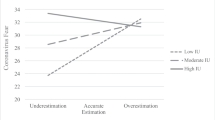Abstract
Threat messages are often used to try to change people’s behavior. Several dual-process models propose that threats can either cause people to control their fear or mitigate the danger. A critical review of these dual process models suggest that severe threats or susceptibility are more likely to result in fear control while self-efficacy should result in the more adaptive outcomes. An online experiment tested these predictions with 1802 men across four English-speaking countries—Australia, Canada, the UK and the US. Path analysis results supported a strong relationship between gore and defensive reactions consistent with the fear control process while efficacy shows a closer relationship with protection motivation and the danger control process. The results provide strong support for this revision of the dual process approach, with fear provoking defensive motivations, and efficacy resulting in self-protection. These results show scaring people is less effective than providing options to avoid the danger.
You have full access to this open access chapter, Download conference paper PDF
Similar content being viewed by others
Keywords
These keywords were added by machine and not by the authors. This process is experimental and the keywords may be updated as the learning algorithm improves.
Threat messages are often used to try to change people’s behavior. Several dual-process models propose that threats can either cause people to control their fear or mitigate the danger. A critical review of these dual process models suggest that severe threats or susceptibility are more likely to result in fear control while self-efficacy should result in the more adaptive outcomes. An online experiment tested these predictions with 1802 men across four English-speaking countries—Australia, Canada, the UK and the US. Path analysis results supported a strong relationship between gore and defensive reactions consistent with the fear control process while efficacy shows a closer relationship with protection motivation and the danger control process. The results provide strong support for this revision of the dual process approach, with fear provoking defensive motivations, and efficacy resulting in self-protection. These results show scaring people is less effective than providing options to avoid the danger.
Author information
Authors and Affiliations
Corresponding author
Editor information
Editors and Affiliations
Rights and permissions
Copyright information
© 2016 The Academy of Marketing Science
About this paper
Cite this paper
Basil, M.D., Basil, D.Z. (2016). Fear Versus Efficacy: Evaluating Dual-Process Models with Workplace Safety Messages. In: Groza, M., Ragland, C. (eds) Marketing Challenges in a Turbulent Business Environment. Developments in Marketing Science: Proceedings of the Academy of Marketing Science. Springer, Cham. https://doi.org/10.1007/978-3-319-19428-8_5
Download citation
DOI: https://doi.org/10.1007/978-3-319-19428-8_5
Publisher Name: Springer, Cham
Print ISBN: 978-3-319-19427-1
Online ISBN: 978-3-319-19428-8
eBook Packages: Business and ManagementBusiness and Management (R0)




